Weird and wonderful farm kit launches from Agritechnica
While the big players often steal the limelight at shows, down the side alleys and in shadowy corners there are all sorts of unusual bits of kit from manufacturers you’ve probably never heard of.
We round up a few from November’s Agritechnica event in Germany.
See also: New Holland T7 gets novel bulb planting modification
Evum aCar
If you’re generating electricity on farm and need a nimble four-wheel-drive runabout, the battery-powered Evum aCar could be your dream motor.
Tagged as a “green” utility vehicle, it has a top speed of 70kph and a range of up to 120km.
Charging from a standard power source is said to take five hours, while a three-phase rapid charger will bring that nearer to two.
It has the potential to be a fairly useful load-lugger, with a payload capacity of 1.1t and a towing limit of up to 1.5t.
And, thanks to a 230V external socket, the aCar can also be used as a mobile power bank to run devices up to 3kW.
The cab is utilitarian but comfortable – a heater is standard and air-conditioning will soon be an option.
There is a range of body options, running from a standard chassis-cab to a stretched long-wheelbase with flash-looking aluminium tool-locker.
Prices start from €37,990 (£33,000).
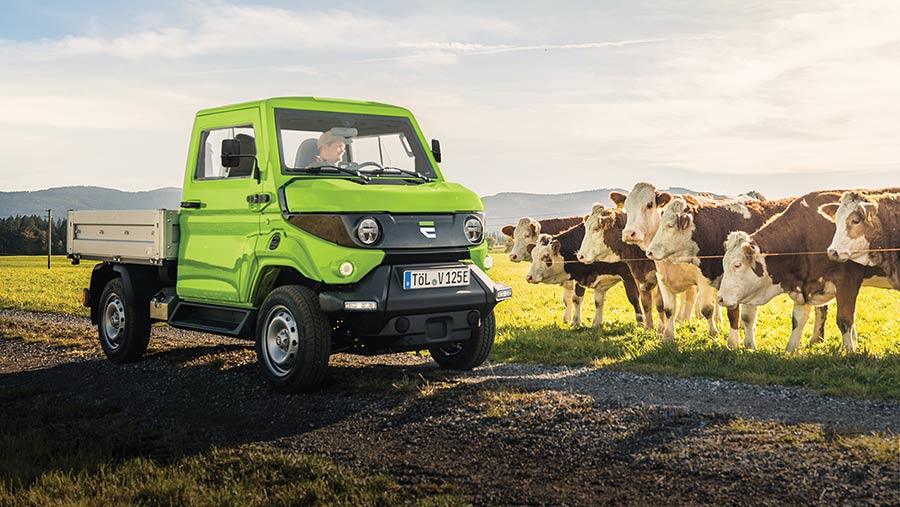
Evum aCar © Evum-Motors
Ortomec lettuce harvester
Based close to Venice, Italy, Ortomec has been building specialist kit for salad and herb growers for the past 25 years.
Its latest development is a semi-autonomous lettuce harvester that does away with the need for having pickers on the ground.
Up front, a reciprocating knife snips the salads off at ground level and an overhead chain and bar arrangement gently nestles them onto a conveyor.
This carries them up to the sorting table, where they are manually loaded into crates stacked at the rear on pallet forks, which lower to the ground once full.
In work, a row feeler detects the bed-former wheelings and follows accordingly, so the only human input required is to swing the rig around on the headland using the machine’s joystick controls.
Available on monstrous 3m-long tracks or wheels, the Ortomec 9000 is powered by a 75hp Deutz diesel engine driving a hydrostatic transmission. It comes in at a cool €160,000 (£139,000).
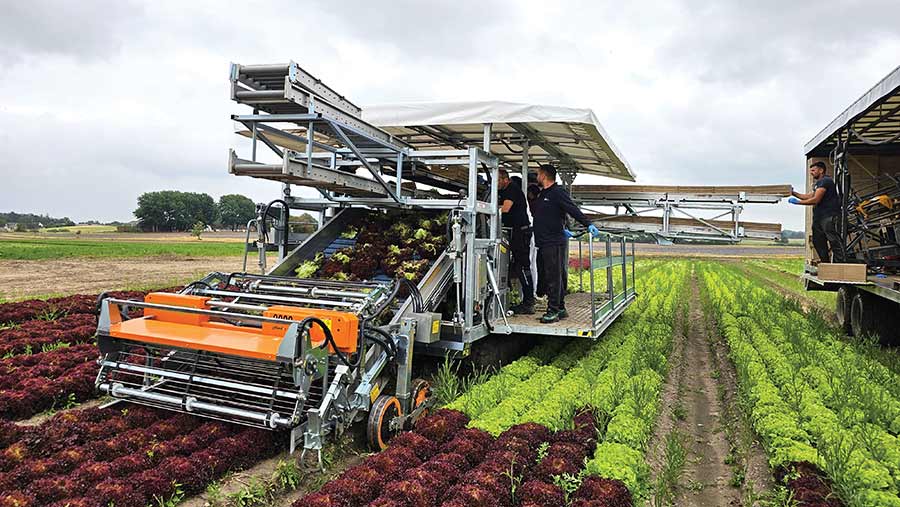
© Ortomec
Fimaks three-string baler
Turkish firm Fimaks builds a vast range of kit, from forage harvesters and feeder wagons to pivot-steer loaders and slurry tankers.
But what caught our eye was the company’s souped-up conventional baler.
With a 46cm-wide and 36cm-tall chamber, the 5690 is available with either two or three knotters – the latter option apparently making it possible to produce bale weights of up to 40kg in hay and 30kg in straw.
The knotters are off-the-shelf Rasspe units – used by all the big players in the baler game – fitted with a centralised grease bank and twin cleaning fans as standard.
Shaft drives and over-run clutches are employed for the major components to keep downtime to a minimum and there is a choice of 1.5m- or 2m-wide pick-ups. Prices start from €26,070 (£22,600).
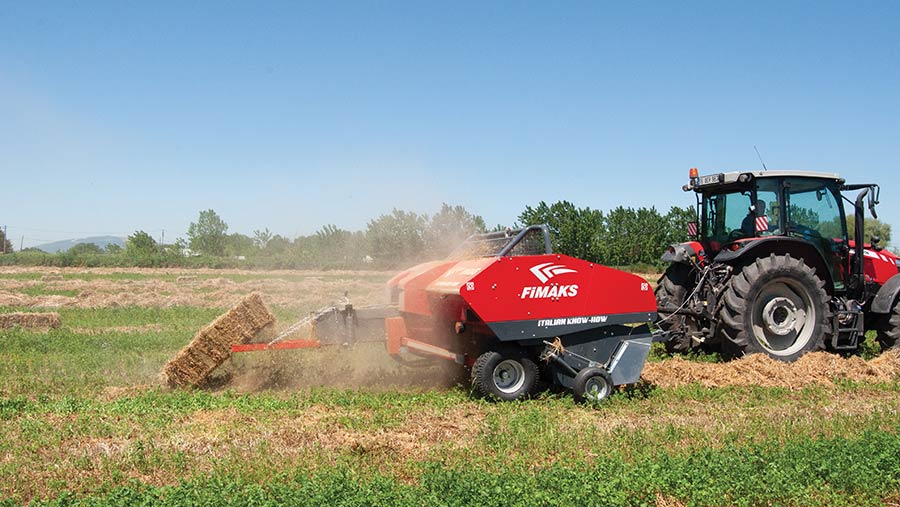
© Fimaks
Landworks Tugger
Chinese manufacturing giant Intradin used Agritechnica as the European launchpad for its Landworks outdoor powered equipment brand, which includes petrol-powered chippers, leaf vacuums, rotovators and post-hole augers.
And central to the line-up is the battery-powered Tugger (pictured below) with its 48V, 500W brushless motor.
At first glance you’d be forgiven for assuming it’s just an abandoned mobility scooter, but Intradin insists it is a purpose-built load hauler.
It’s rated to tow a maximum of 1.2t and will travel at up to 7kph.
Depending on the work being done it will apparently run for up to four hours, but will then need the same amount of time to recharge the 9Ah lead -cid power pack.
The Tugger three-wheeler costs about £795. Hook one of Landworks’ petrol-powered suck’n’chop leaf vacuums on the hitch and you’ll add a further £2,000.
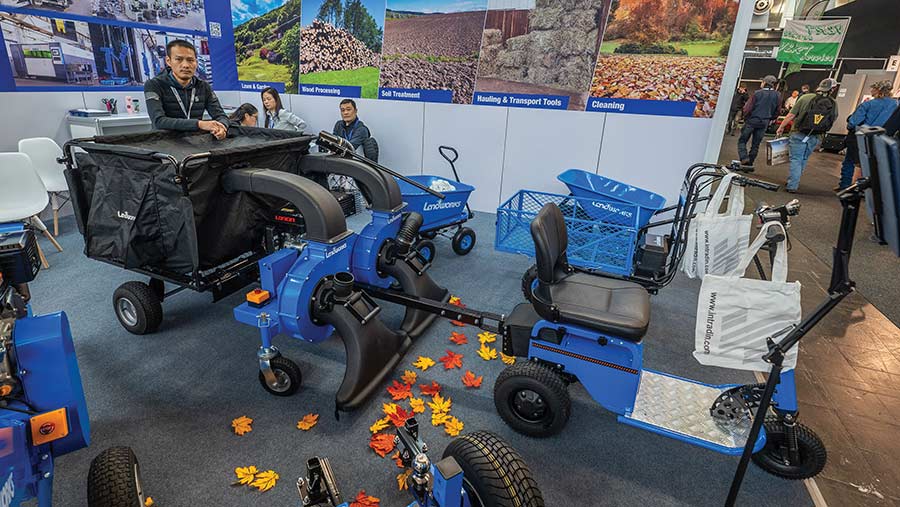
Tugger © Intradin
TVZ axles
Italian axle manufacturer TVZ had a selection of unusual-looking axles on its show stand.
Like rocking-beam setups of old, the use of a split “stub” is said to make this trailing arm arrangement well suited to uneven terrain – if one wheel drops into a hole or rides up over a hump it doesn’t kick its opposite number out of kilter.
That’s all helped by the addition of hydraulic self-levelling suspension, which is an important extra when you’re running trailers around on mountainsides in the Alps.
TVZ’s running gear range is available in all sorts of formats – air suspension, leaf springs, passive or active steering, and plenty more.
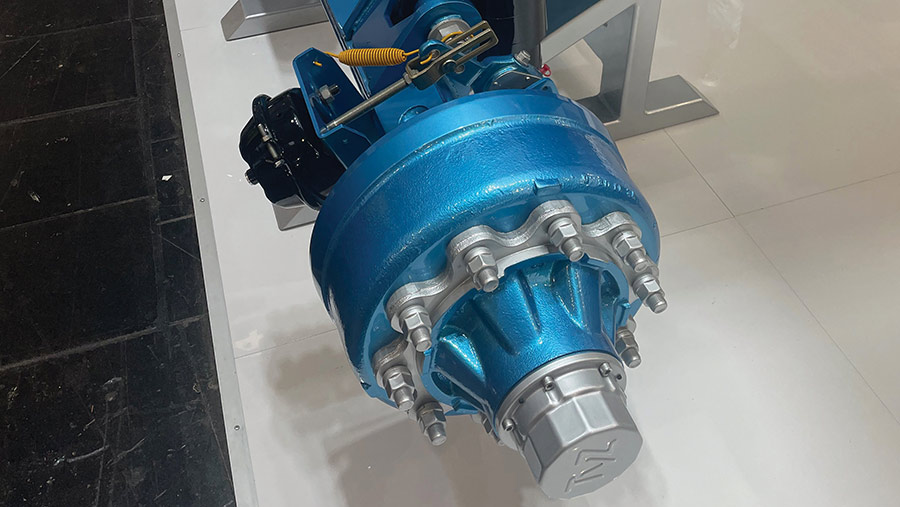
© TVZ
Agrokalina cultivation kit
There was a strong Ukrainian presence among the exhibitors at Agritechnica, one of which was cultivator, drill and roller maker Agrokalina.
Its Yastrip strip-till was apparently receiving quite a bit of interest from European growers looking to reduce their maize establishment costs.
This is apparently a top-end machine in terms of quality, but the company appreciates that to gain a foothold it needs to kick off with budget pricing. As such, an eight-row folding Yastrip comes in at €24,338 (£21,100).
Also in the range are its novel 6-10m Crush three-gang folding rollers (pictured) with interchangeable sections that allow operators to switch from Cambridge rings to bladed cover-crop chopping drums.
The price for a 6m set is €7,177 (£6,230), with an extra set of drums adding a further €4,668 (£4,050).
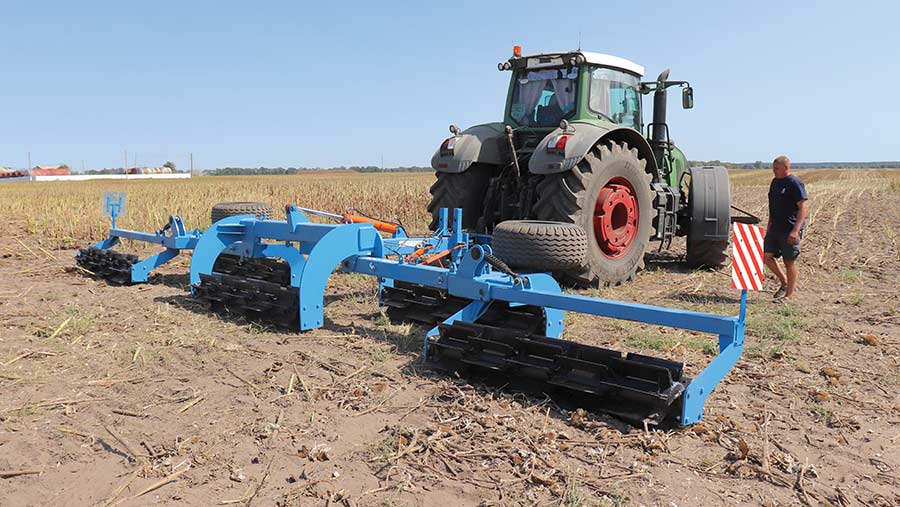
© Agrokalina
IDM greenhouse sprayers
Spanish company IDM specialises in compact self-propelled sprayers for the fruit and vegetable sectors.
Although it might not look overly nimble, this six-wheeled skidsteer unit can swing round at the end of a run within 2m.
That’s thanks to having its front and rear axles set marginally higher than the mid wheels, allowing it to swivel within its own length.
Tank sizes range from 200 to 500 litres and there is a ruck of boom and pump options depending on the target crop.
The company also builds high-clearance four-wheelers that look just like miniaturised broadacre self-propelleds.
With hydraulically adjustable track widths, they’re designed for crops such as strawberries and baby leaf spinach, where bed widths vary.
Prices for the mini six-wheelers start from about €15,000 (£21,130), while larger high-clearance machines kick off at about €30,000 (£26,000).
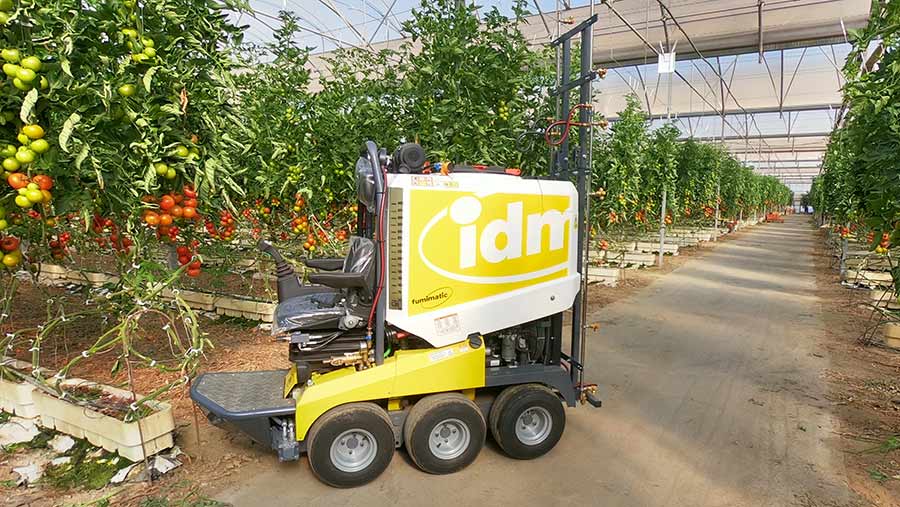
© IDM
Cosmeco bedformer
If you’re after a machine that will produce ridged beds from stubble in just one pass, Italian firm Cosmeco might have the answer.
Its B70 bedformer employs a pair of rotors running crossways to mound soil in a central ridge that can be up to 70cm high.
At present, the company’s range is targeted mainly at horticultural crops such as asparagus, but a version for wider, shallower beds could be on the cards for growers looking to reduce the intensity of seed-bed preparation operations.
A multi-ridge version for potatoes is currently thought to be too complicated to develop.
Depending on the size of the unit, prices vary from €15,000 to €27,000 (£13,000 to £23,500).
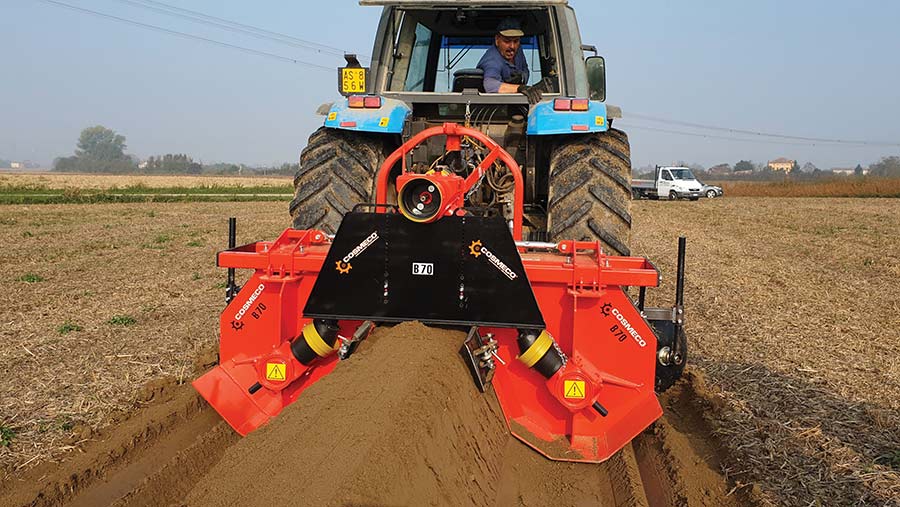
© Cosmeco
Kloppenburg haulm puller
The loss of potato desiccants has spawned several alternative methods for haulm destruction.
While topping will help to prompt skin set and halt tuber growth, its effects are limited, which is a particular issue for seed growers, for whom uniform sizing is essential.
Dutch company Kloppenburg’s solution is this haulm puller.
Used in conjunction with a front topper, its individually mounted units use row-following fingers to stay on the straight and narrow.
Pairs of air-filled rubber rollers rotate against each other, grabbing hold of the stripped plant stems and pulling them off the tubers.
Rear diablo rollers maintain the working depth and also work to firm the ridge back up.
Kloppenburg says the haulm puller’s thorough action means tuber growth immediately ceases and skin set starts, with the result that harvest can take place up to one week earlier than would have been possible with chemical desiccants.
A four-row model costs €37,750 (£32,780).
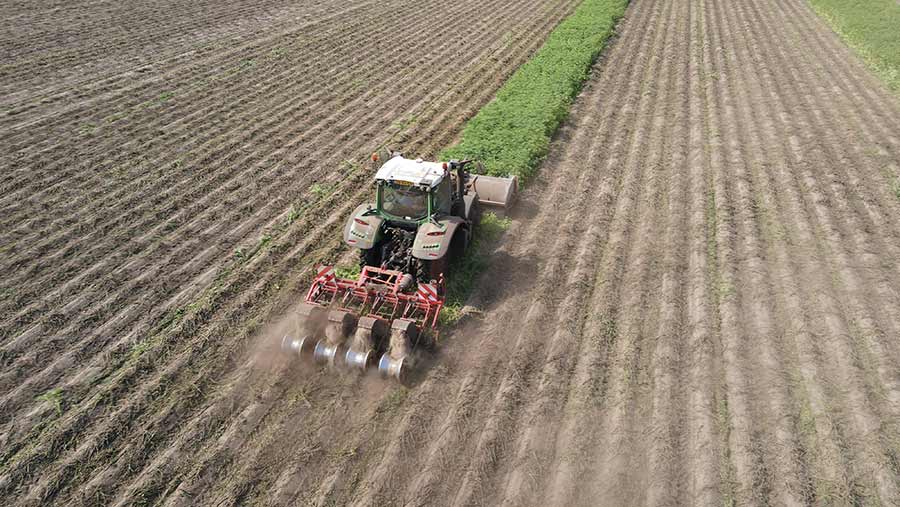
© Kloppenburg
Slopehelper fruit robot
Slovenian firm PEK automotive specialises in developing electric vehicles for unusual applications and has recently been concentrating its efforts on autonomous machines for use in horticulture.
The Slopehelper is a tracked skid unit that can have any number of attachments mounted on it.
Currently, the machines working in the field are employed in vineyards and orchards and are equipped with pruners, mister-sprayers, in-row toppers, power harrows and harvesting rigs.
Most intriguing is the firm’s apple-harvesting arm, which uses cameras to measure fruit size, select which are big enough to make the grade and then pick them.
For next year we’re told there will be a system that uses electro-conductivity sensing to assess each apple’s ripeness and select them accordingly.
Rather than using GPS to navigate, the Slopehelper employs a combination of radar, radio communications and AI technology to recognise and remember routes – something that makes sense in vineyards and orchards, where runs through the crop are repeated multiple times through the growing season.
Using a 48V system, the unit’s batteries will provide 8-14 hours of run time depending on the work being done.
And, with a three-phase connection, it will be back up to full power and ready to go again after an eight-hour charge.
Prices depend on what kit is selected but, as a rough idea, a Slopehelper equipped with two implements is likely to set you back €160,000 (£138,460).
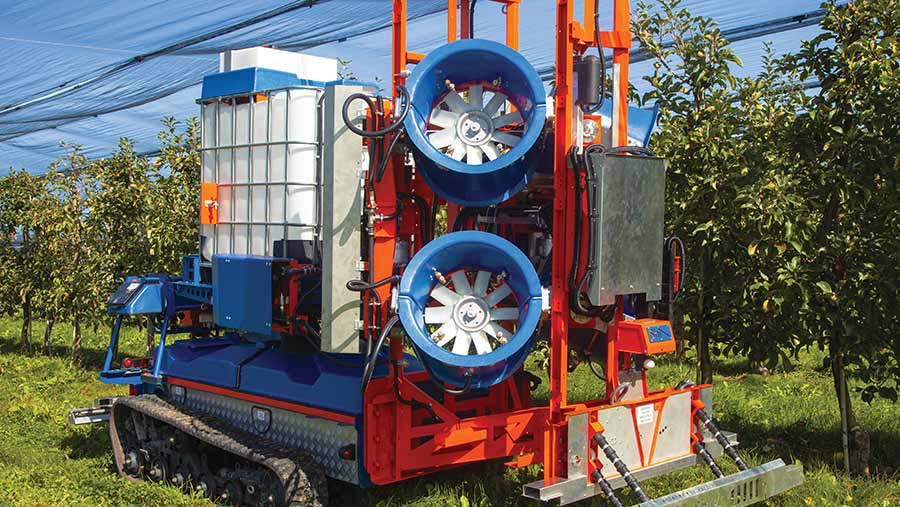
© PEK
SmartFence Robot
The battery-powered SmartFence robot, developed by a team at the University of Kassel, is designed to patrol electric fence lines, keeping them clear of vegetation and detecting any faults.
To do this, it employs a 3D camera to identify the stakes and wire. It then trundles along assessing the condition of the fence while simultaneously cutting any growth below.
The garden-style finger-bar hedge-trimmer is mounted in a simple floating parallelogram frame and swings back out of the way when it encounters plastic, metal or wooden posts.
Because it uses camera guidance, it can navigate its way along curved and undulating fence lines and, at the same time, can detect leaning posts and sagging or broken wires.
In future, it is hoped it will also be able to measure the shock in the wire and identify any points where it is earthing out.
It will amble along at up to 3kph, with battery life dependent on how thick the vegetation is.
Commercial versions are being developed in collaboration with German electric fencing firm Horizont and should be available in the next three to four years.
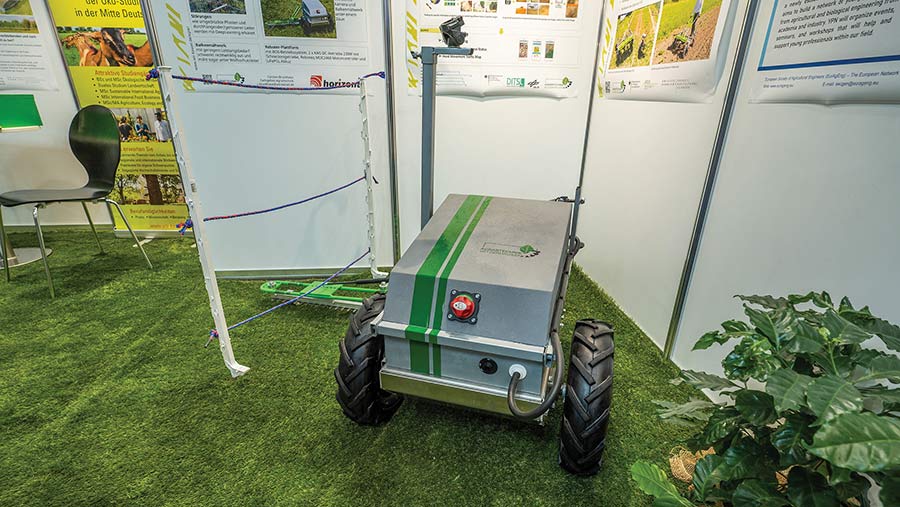
© University of Kassel
JKI slug robot
Spawned from the engineering minds at the Julius Kuhn Institute research centre near Leipzig, this tracked slug control robot employs a 3D camera, using image recognition to detect and target slugs.
Once identified, the robot arm uses a suction cup to grab any malicious molluscs and imprison them in a sealed container to be dealt with later.
Earlier versions trialled electrocution as a means of cutting numbers, but surprisingly even a 5,000V shock didn’t do the job.
The research team is looking at more effective ways of killing the slimy pests.
One thought is that, due to the cannibalistic nature of slugs, slicing them up might further enhance the efficacy of the robot – with their dismembered remains attracting yet more into the machine’s area of operation.
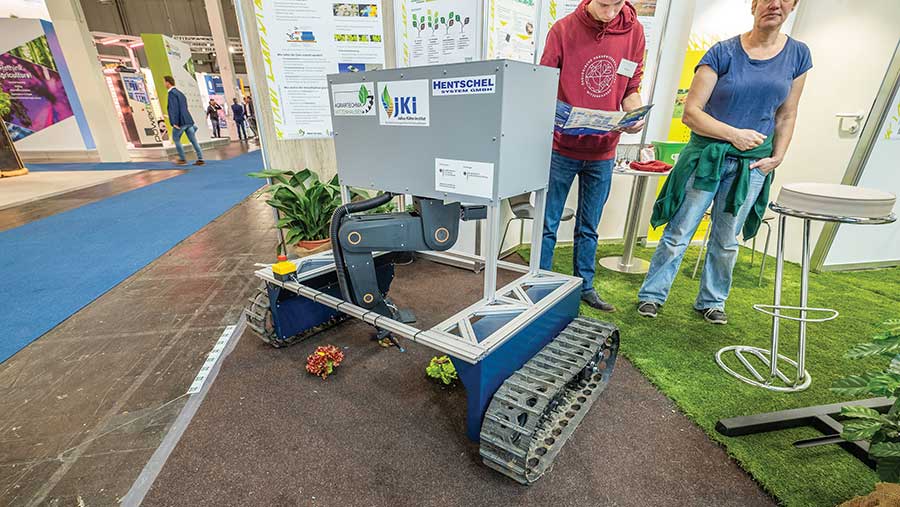
© Julius Kuhn Institute
Cetinkayalar trailed combine
If you’re in the market for a new combine, but can’t quite stretch to the huge sums of money demanded by mainstream manufacturers, Turkish firm Cetinkayalar might have the answer.
For €12,000 (£10,380) you get a brilliantly simple piece of kit that uses a conventional drum and concave to separate grain and straw.
A giant sucker/blower then lifts the crop residue off the sieves, chops it and blows it into a trailer hitched up behind.
Meanwhile, the grain is lifted into a tilting hopper with a simple chute that discharges into a corn cart alongside.
A baler-style pick-up is standard fitment on the front end, so crops do need to be swathed in advance of harvest.
The power requirement is pretty modest – with a swing-over offset drawbar, it needs a tractor of at least 48hp to operate effectively.
Mr Cetinkaya has been building a version of his trailed threshing machine since 1979, and we’re told there are some 10,000 out working in 38 countries across the globe.
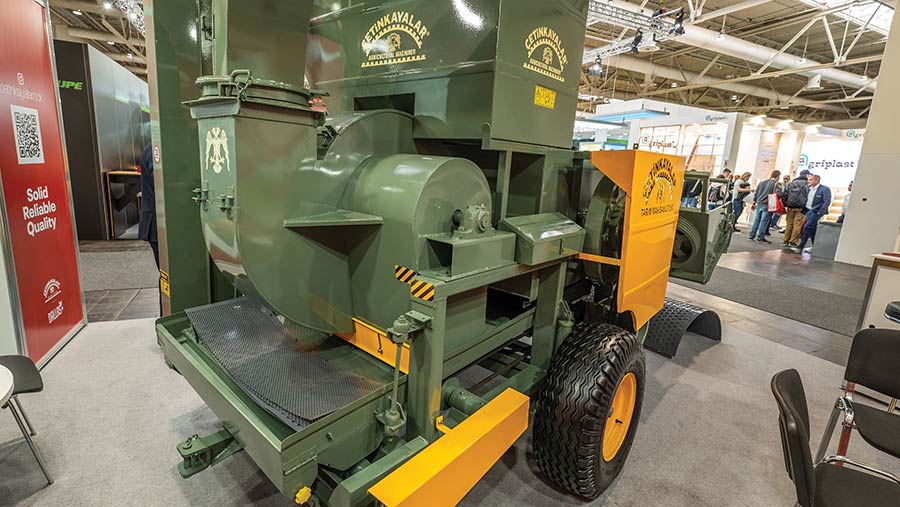
© Cetinkayalar
IMeG dump-loader
Italian outfit IMeG builds a range of three-way tipping trailers that can double up as “low-loaders”.
By positioning the wheels closer to the mid-point on the chassis, the body is able to tip almost to the floor.
Two short ramps then make it possible for a mini-digger or similar tracked machine to hop up onto the tipping bed, though you wonder whether the checker-plate steel floor will provide enough grip in the wet and cold.
Body lengths range from 3.5m to 4.5m and load ratings are between 6t and 8t. There is a choice of running gear, including hydraulic or over-run brakes. Prices start from about €8,000 (£6,920).
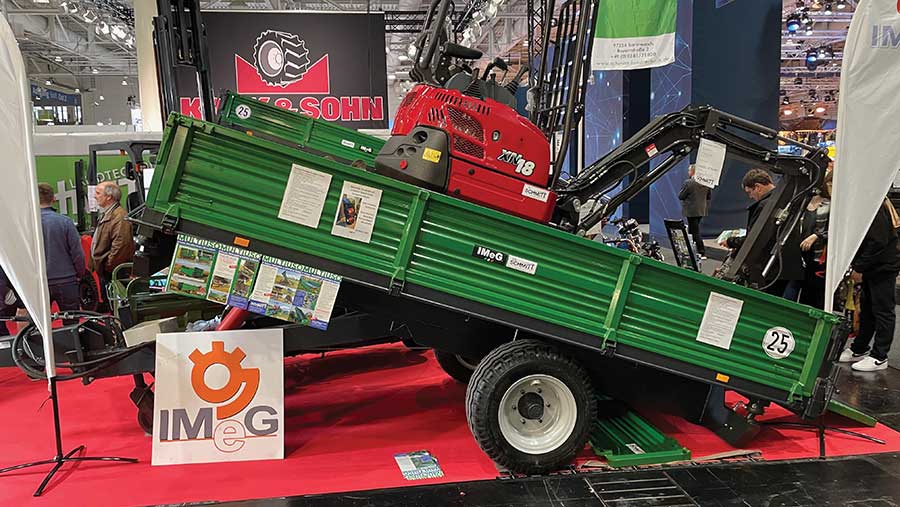
© IMeG
Farmdroid spot sprayer
It was four years ago that Farmdroid’s solar-powered “seed and weed” robots first appeared and, having sold some 400 in that time, the company has gained a name for herbicide-free weed control in row crops.
But with their latest development, the firm’s Danish owners now want to broaden its appeal and extend its reach to conventional growers.
Over the past few years they’ve worked with TeeJet to come up with a spot-spraying kit that can be mounted on the power unit.
Using the same electronic nozzle actuators as employed with the sprayer tech specialist’s pulse-width modulation systems, the new setup can be used to target either the crop plants or the bare ground between them.
In that way, insecticide, fungicide, fertiliser and selective herbicide rates can be cut to a fraction of the normal broadacre rate (Farmdroid says savings of up to 96% are possible), and it also means cheaper non-selective herbicides can be used between plants.
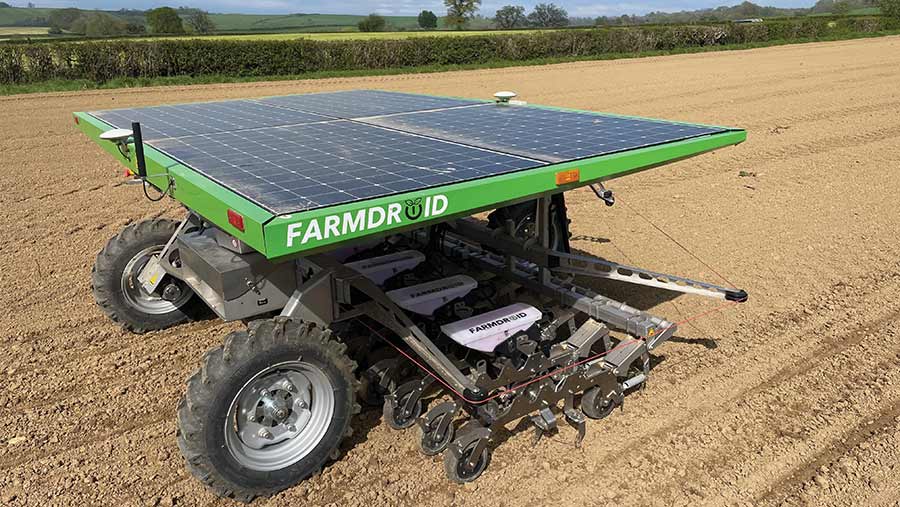
© Farmdroid
Jenz HackThor
The prototype Jenz Hackthor self-propelled woodchipper has a cab that can lift to a vertigo-inducing 4.5m and rotates to give the operator a bird’s-eye view of the machine’s on-board crane, intake and discharge chute.
Based on a six-wheel-drive MAN truck chassis, power is provided by a 520hp straight-six engine driving through an intermediate gearbox direct to the 820mm-diameter drum.
Capable of running at up to 56mph, the HackThor has apparently been designed specifically for processing roadside brash.
As the operator finishes one pile of material, they can set the machine in motion to move on to the next without bringing the cab back down to earth.
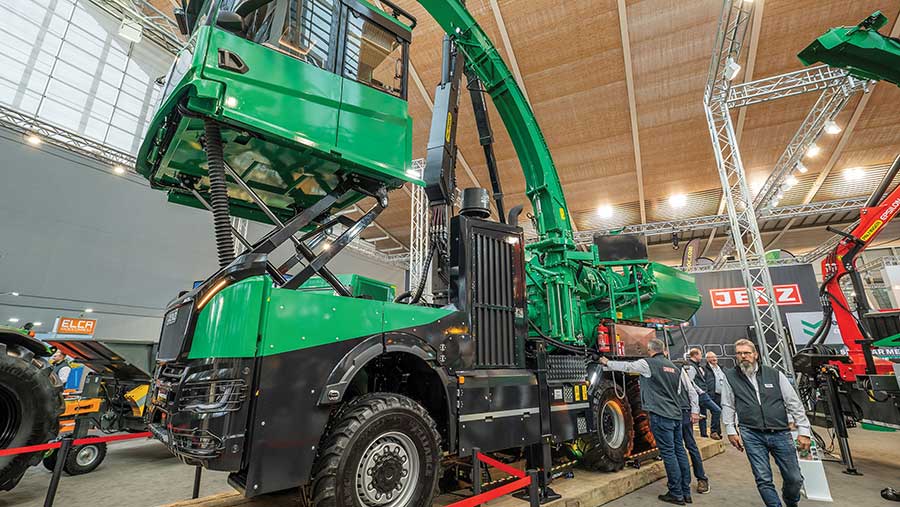
© Jenz

